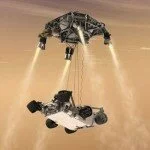 A Small car size, NASA’s 900-kg Curiosity spacecraft will set to hit Mars through the Martian atmosphere at 13,000mph on Monday, a great success in first manned Mars mission.
A Small car size, NASA’s 900-kg Curiosity spacecraft will set to hit Mars through the Martian atmosphere at 13,000mph on Monday, a great success in first manned Mars mission.
Human landing on Mars will be an International probe of rocks, soil samples and the local geological settings to detect Martian atmosphere for mankind in Red Planet whether it supports habitual environment or not.
It is for the first time, Curiosity precision landing on another planet will be made by using the entire sky crane manoeuvre and a “guided entry” system, with jet boosters firing at the back of the craft, making easy to go towards the Mars Gale crater. According to reports, SUV rover is five times larger than earlier Mars exploration rovers Spirit and Opportunity, considering eight rocket thrusters, 17 cameras and with a suite of 11 advanced instruments equipped by scientists.
Curiosity that will operate for nearly two years will land on Mars Gale Crater after covering 570 million km distance and its 1.5 billions heat shields will reach more than 2,000 degrees C as it takes off.
Talking to media persons, Indian engineer Ravi Prakash who is helping Curiosity rover to manoeuvre complex entry, descent and landing, said that this mission is full of challenges and requires thousands of events to be succeeded in a matter of minutes.
“If we had the motive, if it was important enough I would say within 10 years we could be there,” A NASA scientist told reporters, adding the first images from craft would be expect about 90 minutes after the touchdown.
The world’s biggest supersonic parachute’s working are monitoring by NASA’s scientists at the mission control room at Nasas jet propulsion laboratory in Pasadena near Los Angeles. And if mission will successful, it hit a historical moment in world record as the landing of astronauts on the Moon in 1969